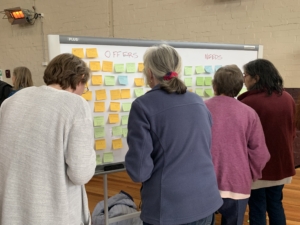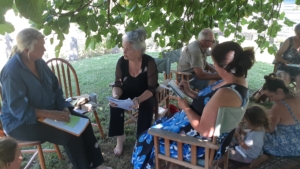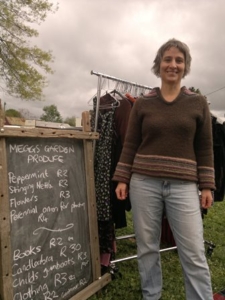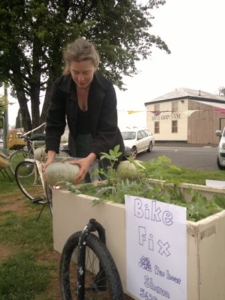Offers and Needs Workshop and Market
More information
The Offers and Needs Workshop and Market is one of the most effective methods for revealing local wealth, rapidly deepening connections, and regenerating economies. In the two-hour guided process, people meet to identify and exchange their passions, knowledge, skills, resources, and opportunities.
This is a powerful yet simple process which shifts the narrative around community resources, creating a culture of trust, empathy, and connection.
Samantha has facilitated a number of markets over the course of the last two years.
Here are a few activities that participants of previous Offers and Needs Markets have connected on: Crafternoons (Craft/sewing), Re-purpose/renovate garments, Bio-dynamic knowledge sharing, a talking partner, a friend, a hiking buddy, dog training, wood splitting, manuscript review.
Here’s what participants said they enjoyed about their experience:
“I found it heartwarming to meet and share with other people. Found a lot of commonalities in what people were offering and needing.”
“It’s interesting to meet others, hear their needs and offers and reflect and define my own”
“Connective, friendly, gentle process to know my own needs and wants more deeply and others. Loved the small group sharing.”
“E. F. Schumacher’s famous epigram reminds us that when it comes to community building, “Small is beautiful.” To that I would add, trust is everything. “
Cormac Russell, social explorer and Asset Based Community Development guide
6 minute video describing the workshop process: https://vimeo.com/356823600
4 minute video: https://www.youtube.com/watch?v=ArAxQaXyNgc
Community Exchange System
The Community Exchange System (CES) is a community-based exchange system that provides the means for communities to trade and exchange their goods and services, both locally and remotely. It could also be described as a global complementary trading network that operates without money as it is commonly understood.
Unlike the conventional money-based exchange system, the CES has no physical currency. The idea that such a currency is necessary before any trading can take place is an ancient one and increasingly irrelevant in this day and age of computers and the Internet. Information can replace currencies and at the same time eliminate most of the problems associated with regular money.
Apart from using information instead of circulating currencies to facilitate exchange, this exchange system is community-focused in order to build community and keep wealth where it is created.
As metric currencies are information they do not have to be ‘created’ like conventional money so there is no need for an issuing authority or for a supply of it, and none is required to start trading. ‘Money’ in these systems is a retrospective score-keeping that keeps a record of who did what for whom and who provided what to whom. There can never be a shortage of information as there can of money, as information does not have to be created and limited by a third party (banks or government) in order to give it value and meaning. For this reason the concepts of borrowing, lending and interest are meaningless in the CES.
There are many different types of alternative or complementary exchange systems and they are growing in popularity throughout the world. Some use ‘hard’ currencies, where notes and coins are issued by the group for their own use; others use time as a ‘currency’ rather than notes; and yet others use a ‘virtual currency’ which is the recording of the values of goods and services exchanged.
Complementary exchange systems foster the real wealth of communities and rebuild a sense of worth and self-esteem among their users. Around the world they report an increased sense of vitality in all sectors of the communities using them. While these exchange systems might have a slightly different function for each of these sectors, they certainly have relevance to all.
These systems provide infinite opportunities for exchanging one’s narrow specialisations for the goods and services offered by others. In this way a complementary exchange system acts like a supplementary currency, creating an additional stream of value in a community. By supplementing conventional cash flow with a local exchange system a community can provide an additional source of essential goods and services that become scarce in economic downturns and protect itself from changes and fluctuations in the national money supply.
I help you, and you help another—and someone else helps me. The recipients of help become, in turn, the providers of help. What goes around comes around. By helping others you become entitled to receive goods, services or help from someone else. When you receive something, someone else is entitled to claim from the community the equivalent of what they provided.
How does it work?
CES exchanges compile and distribute a directory of goods and services offered by the users registered with them, as well as a list of their ‘wants’ or requirements. When a user requires something advertised in the directory the seller is contacted and the trade takes place. The buyer ‘pays’ the seller by signing a trading sheet provided by the seller or by handing over a cheque-like trading slip that records how much the buyer is agreeing to be debited by the seller for the goods/service delivered. The slip is either handed by the seller to a group administrator who will enter the amount into the computerised system, or the information is entered directly by the seller. Sales are recorded as credits for sellers and as debits for buyers. The central book-keeping system records the relative trading positions of the traders. Those in credit can claim from the community goods and services to the value of their credit and those in debit owe the community goods and services to the value of their debit. Traders receive a regular statement of account that lists their trades and gives their balance at the end of the period. Information about the trading position of others prevents unscrupulous buyers from exploiting the system. Newsletters assist in building links and enhancing the sense of community.
Is this a form of Barter?
No! Barter almost always involves bargaining between two individuals to establish the relative worth of the goods or services they wish to exchange. There is no bargaining in the CES as the receipient is in no way obligated to the provider. The recipients of value ‘pay’ for what they have received by delivering/selling something to other traders in the community at a later time. Complementary exchange systems are as versatile as conventional ones.







